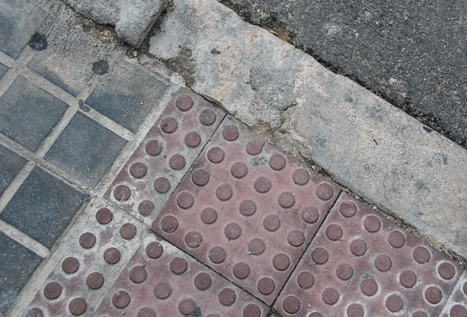Español / English
thresholds
textured
pavements
Designs for All > Thresholds: Textured Pavements

Stone materials are traditionally used to build roads ever since the antiquity and specifically after Greece. That tradition was also maintained in Etruria and developed along a splendorous era during the Roman Empire. At that time, systems such as stone blocks where widely developed to build roads. In England during the XVIIIth century inventor John Smeaton took a big step in studying materials to make compact the building structures for the roads. While making research to rebuild a lighthouse he found out the useful force of calcareous sands to give strength to constructions.
The following advance was due to the discovering of the Portland concrete. About 1824 it was first patented and that fact is attributed to Joseph Aspdin. Even though, concrete is known from antiquity, this hydraulic material is the one that has permitted the advance from natural materials such as rocks towards those elaborated through manufactured systems. With these systems, urban roads have been built creating organists designs and bass relieves systems which allow the ground to be used as a guide, sign o direction system. Among those signal bass relieves systems, Canal designs and bulbs designs may de mentioned as outstanding manners to underline the direction or rhythm of our walks.
Background
Pop art in the sixties was inspired by the life about town and specifically the public signals such as crossing stripes where reproduced in paintings and sculptures as a reference of the art’s inspiration about the city. An icon to be reminded was the picture of the Beatles crossing a road, where the presence of the group’s members was as notorious as the ground itself.Designers
Creators such as André Ricard opened new paths onto the contemporary signal systems in Spain. His transmodern style had an evolution towards portmodern with Javier Mariscal trimming signals in the eighties. Nowadays Martí Guixé is into the field of involuntary memories as a container to design signs based on various types of writings and calligraphies. Actuality/facts
Urban grounds with bass-relieves out of canals and bulbs must be installed by balancing the construction material with the land, for these grounds must be “moving signals” and not “stopping signals”. Other grounds give directions through colors, for example yellow bands in hospitals or white stripes, sometimes with high relieve, on the streets.Tau Company has created “Diet Floor” an intelligent tile ceramic which troughs a message when the diet of the user is trespassed. The tile knows the measures of the user and helps him controlling them. Cercasa Emotile reproduces digital prints on the tile floor creating info’s or artistic designs.
